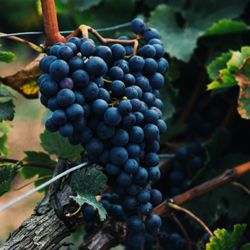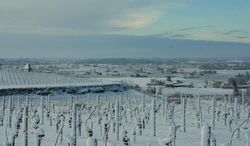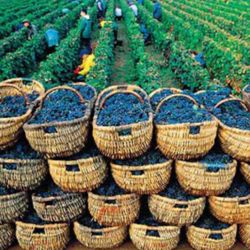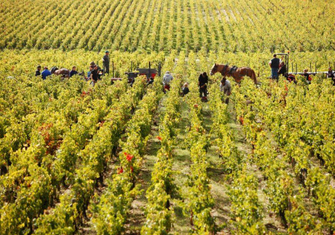The French 2024 vintage could be one of the smallest in the last 100 years. We look at the earliest indicators for wine investors.
2024 vintage predicted to be one of the smallest in a century
 As harvest starts for some, the vintage to be picked is the result of another challenging year for wine makers. France’s agriculture ministry, Agreste, reports that this year’s harvest is predicted to be 16% smaller than 2023.
As harvest starts for some, the vintage to be picked is the result of another challenging year for wine makers. France’s agriculture ministry, Agreste, reports that this year’s harvest is predicted to be 16% smaller than 2023.
This first official forecast published on the 9th August states that national production is expected to be between 40million and 43million hectolitres, down from 47.9million in 2023. This level would see 2024 potentially one of the lowest since 1924.
Climate change and a smaller harvest
The forecast lower-than-average yield for the new vintage is largely influenced by the changing climate patterns endured in wine growing regions. Downy mildew is the primary vineyard threat with wetter, warmer weather creating the perfect conditions for this threat to thrive.
2024 is reported as having the wettest spring season in France since 2008 and the fourth wettest on record by Meteo, France’s national weather agency. Nearly all the vine cultivating regions are reported to have been affected by mildew, and some vineyards have endured significant losses.
 Burgundy had a significantly wet season and the region suffered ‘virulent’ mildew which could see a marked impact at harvest. These conditions have meant extra work and more costs for vineyard owners to protect their vines across France.
Burgundy had a significantly wet season and the region suffered ‘virulent’ mildew which could see a marked impact at harvest. These conditions have meant extra work and more costs for vineyard owners to protect their vines across France.
Frost and hail were also destructive again in 2024 and these dramatic weather events are not confined to winter and early spring. On July 11th 2024 Bordeaux vineyards were struck by hailstones the size of golf balls causing extensive damage. Some areas, such as Sauveterre saw losses of up to 70% and appeals were made for natural disaster aid for some wine growers.
Champagne was also particularly affected by Spring frost and hail. Copious rainfall also caused coulure in France’s famous sparkling wine region where grape flowers failed to develop into berries and vineyard teams had a significant battle with mildew.
French government acts to reduce supply
A further factor with wine production for the 2024 vintage generally is the French state’s initiative to address over-supply of wine and to make the industry more sustainable. The French government committed €200million to a programme of vineyard reduction considering changing domestic consumer trends and challenges in export markets. A survey in 2023 revealed that a third of the growers in the wider Gironde region, where there are thousands, were facing economic difficulty.
 In Bordeaux the CIVB (Bordeaux Wine Bureau) has a co-funded plan with the Ministry of Agriculture to remove a total 9,500 hectares of vines representing 9% of the region’s total vineyard area. In mid-July the ‘grubbing-up’ scheme was behind schedule due to the wet conditions and growers are under pressure to achieve their targets to remove vines before the prescribed deadline. Progress will be reviewed in September.
In Bordeaux the CIVB (Bordeaux Wine Bureau) has a co-funded plan with the Ministry of Agriculture to remove a total 9,500 hectares of vines representing 9% of the region’s total vineyard area. In mid-July the ‘grubbing-up’ scheme was behind schedule due to the wet conditions and growers are under pressure to achieve their targets to remove vines before the prescribed deadline. Progress will be reviewed in September.
Of course, the estates producing investment wines are not impacted by this initiative and supply is therefore not affected by this scheme.
Our view on the early indicators for the 2024 vintage
The highly resourced estates producing investment wines are in a much better position to manage the climatic and economic threats. Year-on-year they are generally coping well with our challenging, changing climate and driving the initiatives for the sector as a whole to protect and improve fine wine production in terms of quality and volume.
 The true impact of all the factors above will be realised once the 2024 harvest is completed. The 2023 harvest was 10% smaller than average yield in Bordeaux and commentators are forecasting that the 2024 harvest will be approximately 800,000 hectolitres across the region. This level is significantly lower than the average annual sales figures of €1.1million - €1.2million in the last few years. The smaller harvest is expected to help bring down the region’s overall stock levels and there is an expectation that these will then be at the lowest level in a decade by 2025.
The true impact of all the factors above will be realised once the 2024 harvest is completed. The 2023 harvest was 10% smaller than average yield in Bordeaux and commentators are forecasting that the 2024 harvest will be approximately 800,000 hectolitres across the region. This level is significantly lower than the average annual sales figures of €1.1million - €1.2million in the last few years. The smaller harvest is expected to help bring down the region’s overall stock levels and there is an expectation that these will then be at the lowest level in a decade by 2025.
The harvest is two weeks later year-on-year in Bordeaux in 2024, but it has started in some regions. Napa’s sparkling wine harvest began in early August for some vineyards due to a hot growing season with peak temperatures up to 41 degrees Celsius. It’s early days, but at this stage ‘supply’ is the key factor!
More news on the 2024 vintage harvest to follow in the coming weeks. See our latest Report for current market trends and speak to our expert team for more information on 0203 384 2262.

